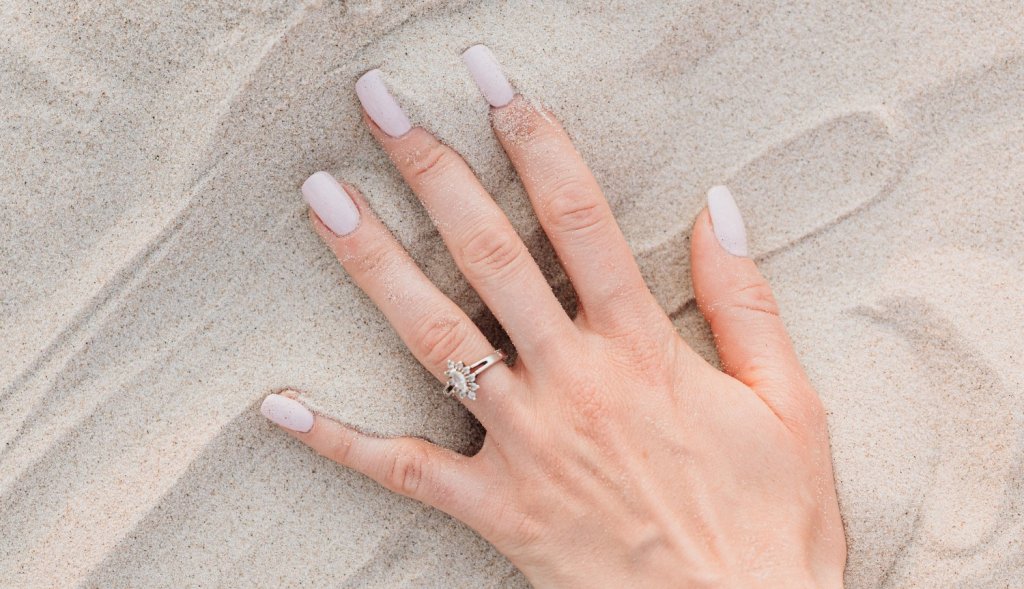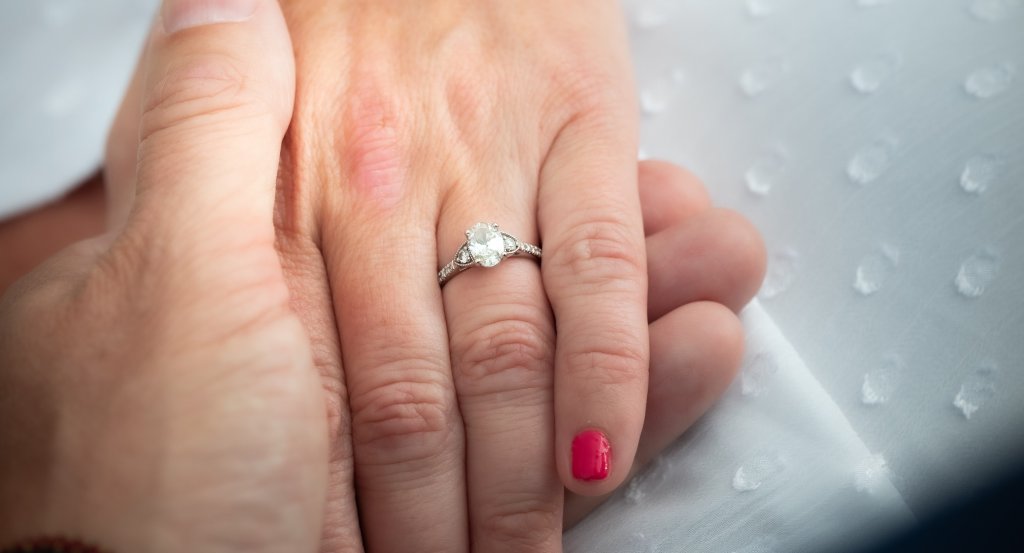What is a Diamond Accent? Everything You Need to Know
Key Takeaways
- While the center stone will be your primary concern (for obvious reasons), the right accents can truly make an engagement ring.
- Accents can be kept to a bare minimum, or they can be used to create an incredibly blingy, bright ring perfect for more outgoing personalities.
- The most obvious choice for accent stones is, of course, the Round Brilliant. It’s versatile enough that it complements any other diamond shape, while also adding the maximum ‘dose’ of extra sparkle.
- But accents can be whatever you make of them. They can be perfectly coordinated with your center stone, or totally contrasting, depending on your bride’s style.

We often talk about rings featuring ‘diamond accents’ but, if you’ve come into this process not knowing a Marquise from a Baguette, or a melee diamond from a fluorescent diamond, then chances are you’re generally left with more questions than answers when we do.
By now, you’re probably already aware that a diamond accent is a smaller, secondary diamond used to complement the larger diamond at the center of the ring. In other words, they’re not the orchestra, they’re the percussion – they’re not the burger, but the fries on the side.
That’s not to say, of course, that accent diamonds aren’t important. For many, many ring designs, they’re just as important as the center stone – and are, after all, what turns a Solitaire setting into something more unique, more ornate, and more sparkly.
But how do you pick a diamond accent? Is it as complex as picking out the center stone – or can you afford to take it easy, and invest a lot less thought into quality? Here are our pointers…
First of All, Are Accent Diamonds Real Diamonds?
Yes. Diamond accents are just as real as the center diamond used in an engagement ring.
Accents can be made from a long list of gemstones. For color, designers will utilize stones like emerald and sapphire as accents – Vera Wang, for instance, places a peekaboo sapphire in many of her designs – but the phrase ‘diamond accent’ will always refer to real diamond.
Since accent diamonds are significantly smaller than other diamonds, some people assume that a cheap alternative like cubic zirconia will suffice, but that’s not the case. Real diamond catches the light far more vividly, and will prove a lot more durable in a ring that’s supposed to withstand decades’ of wear. Besides, the diamonds small enough to be used as accents are a lot more affordable than your center stone will be.
But, despite their smaller size, the same considerations for the Four Cs of quality, as well as fluorescence and proportion, that apply to your center stone will apply to the accents.
Secondly, What Shape Are Diamond Accents?
The most common shape for an accent diamond is the Round Brilliant, but they can be virtually any shape.
The Round Brilliant
As you can imagine, the Round Brilliant is such a popular accent as a result of its superior sparkle. Designed to produce more fire and brilliance than any other diamond shape, the accenting your ring with Round Brilliant diamonds will create a captivating light performance. Smaller diamonds sparkle differently to larger diamonds, even if they feature the same shape, and that variation is extremely popular for engagement rings.
Pros: the Round Brilliant offers matchless sparkle, and a classic appearance that makes it perfect for halos, side stones, and pavé bands.
Cons: not great if you want to keep sparkle at the center of the ring.
The Baguette
While it may represent the polar opposite to the Round Brilliant, the Baguette is another highly popular choice for ring design. Featuring just 14 facets and either a rectangular or elongated trapezium shape, it’s far better suited for use as an accent stone than the showpiece, and makes it possible for jewelers to capture a more minimalistic vibe, without limiting themselves to the Solitaire shape.
These stones aren’t very sparkly, and their simplistic design means that they won’t overshadow your center setting. Tapered Baguettes are great for playing with the illusion of size and depth, while straight Baguettes offer an elegant backdrop for your diamond.
Pros: Baguette diamonds are elegant and beautifully simplistic, and highly effective as accents if you don’t want your diamond to be overshadowed by the setting.
Cons: Baguette diamonds are vulnerable to chipping, so protecting their delicate corners is important – but it can limit your options somewhat. They’re also the wrong choice if you want to create a ring that dazzles with fire and brilliance.
The Trillion (or ‘Trilliant’)
One of the more unusual fancy diamond shapes, the Trillion is great for ‘framing’ the center setting. Their triangular is highly effective for drawing the eye into the center of the ring, by acting as a pair of ‘book ends’ on either side.
Like the Baguette, the Trillion is far more commonly used as an accent. Unlike the Baguette, however, the Trillion brings a good amount of sparkle to the ring, while their shallower depth means that they can look pretty big, even at a low carat weight.
At a glance, the edges of the Trillion can blur with the center stone, and create some highly unique shapes as a result. If you’re not a fan of this, however, then the accents can be set lower, or at an angle than follows the curve of the shank, to differentiate the center setting from its accents.
Pros: it’s a unique shape that makes for a great ‘frame’ to your center setting.
Cons: the Trillion is pretty vulnerable thanks to its three pointed corners, and also considerably less common than the Round Brilliant or the Baguette. Part of this stems from the greater difficulties jewelers face when setting Trillions safely.
The Marquise
The Marquise cut is not the most popular choice for engagement rings, but it offers a romantic, graceful shape that works brilliantly as a center stone – or, in some cases, as an accent. Plus, as of 2022, it’s been quickly gaining momentum in popular opinion once again.
Marquise diamonds cut small enough to be used as accents aren’t so common, but they can be used to great effect. Set horizontally, they can resemble two leaves or petals branching out from the center stone. The effect is similar to that of the trilliant, but a little more delicate in appearance.
Pros: it createsa dainty, botanical effect on either side of the center setting.
Cons: like the trillion, its pointed corners make it a fragile option, but there are ways of setting it safely within the design.
FAQ
Need to know more? Below, we answer your frequently asked questions about accent diamonds – from quality to durability.
What size are accent diamonds?
While it depends on the design of the ring, since everything is relative, but accent diamonds tend to be 0.2 carats or below.
If you’ve got a five carat diamond at the center of your ring, then you can afford to go a little bigger on the accents – too small, and those diamonds could feel inconsequential – but, for most rings, you won’t want (or need) to go much larger than 0.2 carats. If you go much bigger, then the design could wind up resembling a three stone engagement ring.
A general rule for three stone rings is that the two diamonds on either side should be, at most, half the carat weight of your main diamond. So, if your diamond is 1 carat and you pick out accent stones that are between 0.3 and 0.5 carats in weight, the finished ring is likely to resemble the bulkier three stone rings – which may or may not be what you want.
Does clarity matter for accent diamonds?
Yes, but you might get away with a lower clarity grade.
Why? Because it’s harder to spot minor imperfections in smaller diamonds than it is in larger diamonds.
The key here is still to pick out a diamond that is eye clean but, depending on the size of your accent diamonds, this may be possible at the very low end of the clarity scale.
Does color matter for accent diamonds?
Again, yes, but it is important that accent diamonds have more or the same amount of color than the center stone.
If you pick out a center stone with an I color grade, and accent stones with, say, and E or F color grade, then the contrast is likely to pick out the color of your center stone, and make it appear more yellow than it really is.
It’s still best to stick to the Near Colorless group (G, H, I, and J), without going better than your diamond.
Do accent stones fall out?
They can do, but they’re a lot more secure than you’d think (provided the workmanship is good), and can be replaced in a worst case scenario.
Accent diamonds are often held in place by beading, or by channels that can make it appear as though the diamond is ‘floating’ on the shank. Although this can make it seem as though the diamonds are in a precarious position, it’s actually a sign of skilled work. Remember that platinum and alloyed gold are very strong, and it would take a lot of effort to bent them back from the diamond without the help of extreme heat.
Over time, prongs can become a little loose, but regular check-ins at the jewelry store (say, every six months) will stop regular wear and tear from turning into a big issue.
Accents are an excellent way to add a little extra life, sparkle, and detail into any ring design, and knowing the basics will give you a great talking point when you head in for your engagement ring consultation.

Aug 17, 2021 By Willyou.net
Vintage Engagement Rings: The Complete Guide

Mar 26, 2022 By Willyou.net
Low Setting Engagement Rings; The Complete Guide








